When you're selecting fabrics for your next project, you'll find that lace and mesh are often mentioned in the same breath, yet they couldn't be more different in their construction and purpose. While both are characterized by their open-weave patterns, each material brings distinct properties to your design table. From the intricate floral motifs of traditional lace to the uniform grid structure of modern mesh, understanding these differences will directly impact your fabric selection and final product quality.
Key Takeaways
- Lace features ornate, intricate patterns created through complex weaving, while mesh has a simple, uniform grid structure.
- Mesh offers superior breathability and moisture-wicking properties, making it ideal for athletic wear and active use.
- Lace is primarily used for decorative and formal wear, whereas mesh is chosen for functional and performance-driven garments.
- Mesh typically has better durability and shape retention through repeated wear compared to lace fabric.
- Both fabrics can be elastic (90% nylon, 10% spandex) or non-elastic (100% nylon), but serve different aesthetic purposes.
What is Lace Fabric?
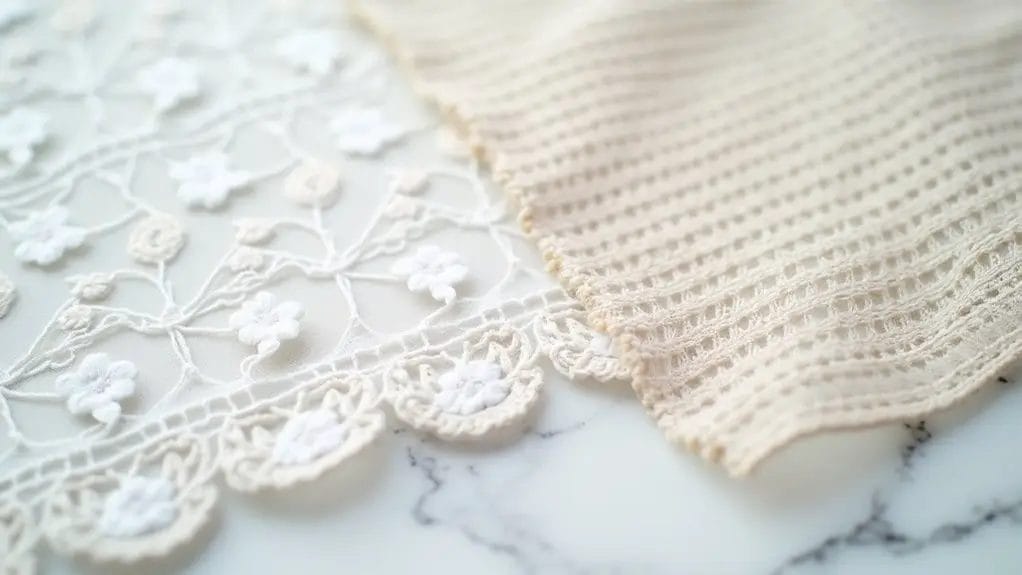
You'll find lace fabric is traditionally crafted from cotton threads or silk fibers, featuring intricate patterns created through complex weaving or knitting techniques that result in a lightweight, decorative structure.
Lace comes in both elastic varieties (90% nylon, 10% spandex) and non-elastic forms (100% nylon), offering versatility for different fashion applications from bridal wear to lingerie.
The fabric's defining characteristic is its ornate, open-weave patterns that create varying levels of sheerness, making it a popular choice for formal attire and special occasion garments where elegance is paramount.
Composition and Characteristics of Lace
While lace fabric's origins trace back to 16th century Italy, its modern composition typically consists of intricate patterns created through complex weaving or knitting of fine threads.
You'll find quality lace often incorporates natural silk for enhanced sheen and superior drape, though cotton threads remain the primary material component.
The characteristics of lace include its lightweight structure and varying degrees of sheerness, determined by pattern density.
Modern elastic lace contains 90% nylon and 10% spandex for stretch, while non-elastic variants use 100% nylon for stability.
When properly crafted, lace maintains its structural integrity through repeated wear and careful washing.
Common Uses of Lace in Fashion
Lace fabric graces a wide spectrum of fashion applications, from elegant bridal gowns to sophisticated evening wear. You'll find it extensively used in women's underwear collections, where its delicate patterns and soft texture provide both comfort and aesthetic appeal.
The fabric's versatility shines in formal attire, adding refinement to cocktail dresses and special occasion garments.
High-end designers incorporate lace fabric into their collections through overlay techniques, sleeve detailing, and decorative trim work.
You'll also see it featured in accessories like shawls, veils, and gloves, where its intricate patterns create visual interest while maintaining an elegant appearance.
What is Mesh Fabric?
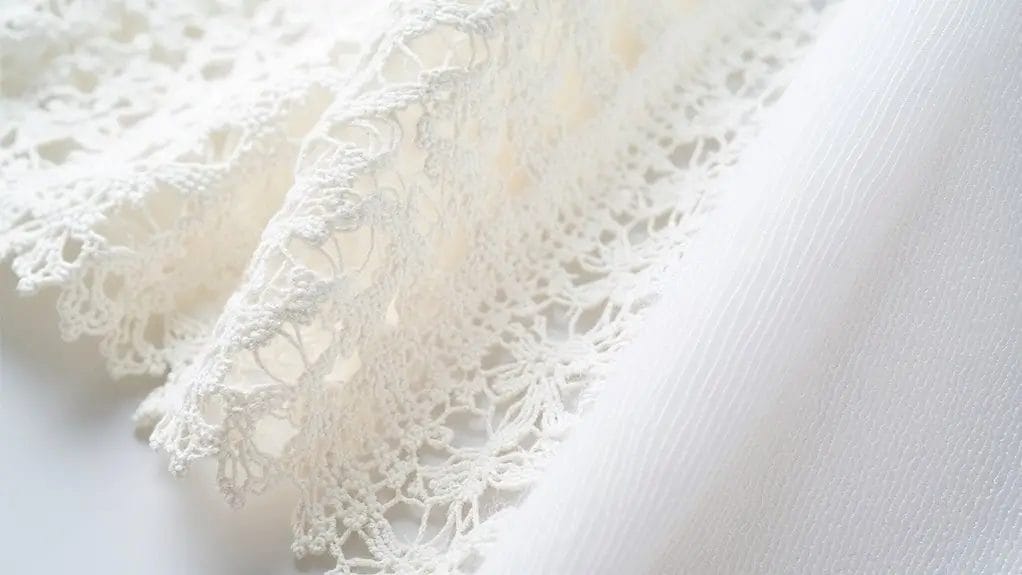
Mesh fabric consists of fine, twisted yarns woven in an open grid pattern, typically composed of 90% nylon and 10% spandex for stretch or 100% nylon for stability.
You'll find mesh's distinctive structure creates excellent breathability and moisture-wicking properties, making it ideal for athletic wear and lightweight fashion pieces.
The fabric's durability and shape retention through repeated wear and washing have made it a staple in everything from sports uniforms to casual summer clothing and modern dancewear.
Composition and Characteristics of Mesh
A versatile performance fabric, mesh consists primarily of fine twisted yarns woven or knitted in an open-grid pattern with uniform holes throughout its structure.
You'll find most mesh fabrics composed of 90% nylon and 10% spandex, delivering peak strength and elasticity, though non-stretch varieties use 100% nylon for enhanced durability.
The fabric's distinctive open-weave construction creates exceptional breathability and moisture-wicking capabilities.
When you're examining mesh fabric, you'll notice its consistent hole spacing and strong dimensional stability.
These characteristics allow the material to maintain its shape through repeated wear and washing while providing superior ventilation.
Common Uses of Mesh in Fashion
From athletic wear to haute couture, modern fashion incorporates mesh fabric across diverse applications due to its exceptional functionality and aesthetic versatility.
You'll find mesh in activewear, where its breatheability enhances performance during intense workouts. Its moisture-wicking properties make it ideal for sports uniforms and compression garments.
In contemporary fashion, designers layer mesh under elastic lace fabric for added dimension, or use it as sheer panels in evening wear. The fabric's structural integrity allows for creative draping techniques while maintaining shape.
Its durability makes it perfect for dance costumes, swimwear linings, and athletic undergarments where ventilation is vital.
Lace vs Mesh: Key Differences Between Lace and Mesh
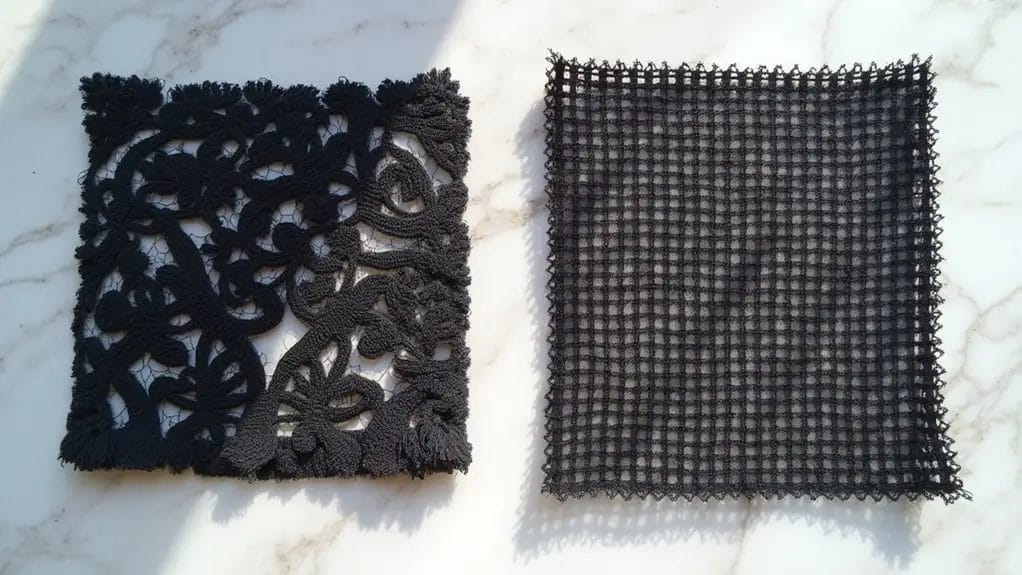
When you compare lace and mesh fabrics, you'll notice lace features intricate, decorative patterns woven into its structure while mesh maintains a simple, uniform grid of holes.
Mesh's open-weave construction offers superior breathability and moisture-wicking capabilities due to its 90% nylon/10% spandex composition, whereas lace's cotton or silk-based composition creates a more delicate, ornate texture that requires gentler care.
You'll find mesh demonstrates greater durability through repeated wear and washing, while lace demands careful handling to preserve its detailed patterns and structural integrity.
Texture and Appearance
The distinctive textures of lace and mesh create fundamentally different visual experiences. When examining lace, you'll notice intricate patterns woven or knitted with varying densities, creating a sophisticated interplay of solid areas and decorative voids.
Mesh, however, presents a uniform grid structure with consistent spacing.
- Lace features elaborate floral, geometric, or abstract patterns that vary in texture and depth
- Mesh maintains even, predictable hole sizes optimized for breathability
- Lace combines solid and open areas to create artistic dimension
- Mesh's systematic grid pattern provides consistent airflow and transparency
These structural differences directly impact their aesthetic appeal and functional performance in garments and decorative applications.
Breathability and Weight
How do lace and mesh compare when it comes to their physical properties?
You'll find that mesh offers superior breathability due to its uniform grid structure of 90% nylon and 10% spandex, allowing consistent airflow through its defined holes. The fabric's lightweight nature makes it ideal for athletic wear and summer clothing.
Lace, while also lightweight, provides varying levels of breathability depending on its pattern density. Its intricate cotton or silk-based construction creates a more delicate weight profile.
When comparing mesh quality to lace, you'll notice mesh maintains its shape and breathability even after repeated use, while lace's ventilation properties depend on its specific weave pattern.
Durability and Care
Despite their delicate appearances, mesh and lace fabrics exhibit distinct durability characteristics and care requirements.
You'll find mesh's nylon-spandex blend offers superior stretch recovery and resistance to wear, while lace's intricate patterns require more delicate handling to maintain structural integrity.
- Mesh withstands frequent washing and maintains shape due to its simple grid construction
- Lace needs gentle hand-washing in cool water to preserve pattern definition
- Mesh's durability makes it ideal for high-movement activities and repeated wear
- Lace requires storage in mesh bags to prevent snags and pattern distortion
Both fabrics need proper care to maximize longevity, but mesh's synthetic composition typically outlasts traditional lace in everyday use.
Choosing Between Lace and Mesh
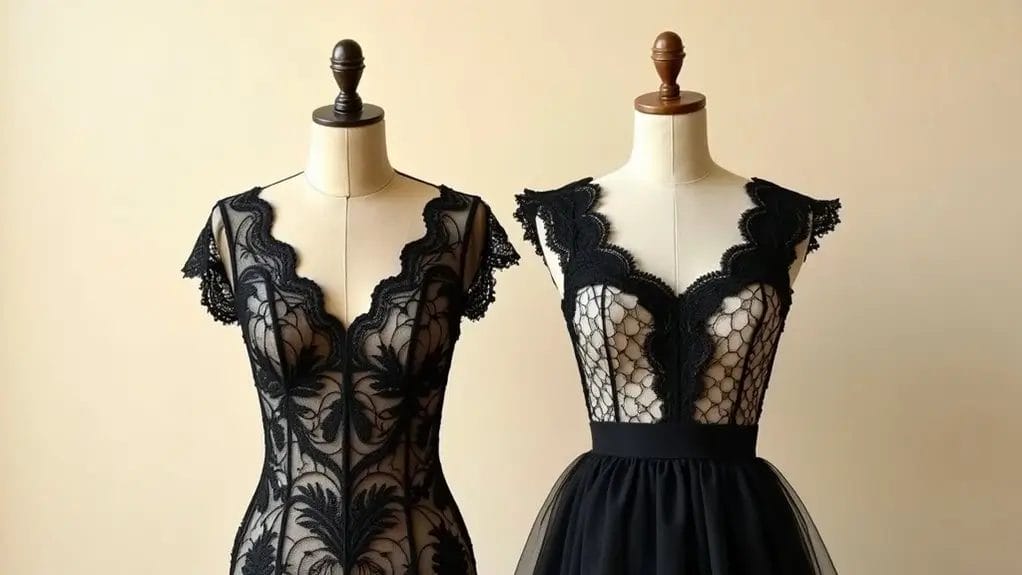
When selecting between lace and mesh for your design project, you'll need to assess functional requirements like breathability, stretch, and durability alongside aesthetic elements such as pattern intricacy and visual depth.
For athletic and performance wear, mesh's superior moisture-wicking properties and consistent 90/10 nylon-spandex blend make it the prime choice, while lace's decorative patterns and varied compositions (from pure cotton to silk blends) excel in formal and special occasion garments.
You'll find mesh provides reliable technical performance with its uniform grid structure, whereas lace offers sophisticated embellishment through its intricate woven or knitted patterns, making each fabric distinctly suited to specific fashion applications.
Factors to Consider in Fashion Design
Choosing between lace and mesh fabrics requires careful consideration of multiple technical factors in fashion design. When selecting your material, evaluate these critical elements:
- Stretch requirements - mesh offers 90/10 nylon-spandex blend for maximum flexibility, while elastic lace provides moderate stretch with a similar composition.
- Breathability needs - mesh's open grid structure delivers superior ventilation compared to lace's denser pattern weave.
- Structural integrity - mesh maintains shape through repeated wear, while lace requires reinforcement for durability.
- Application demands - consider if you'll need mesh's moisture-wicking properties or lace's decorative qualities for your specific design.
The fabric choice impacts your garment's performance, comfort, and overall success.
Suitable Applications for Each Fabric Type
While both lace and mesh serve distinct purposes in garment construction, each fabric type excels in specific applications based on its inherent properties.
You'll find lace most suitable for formal and special occasion wear, particularly in bridal gowns, evening dresses, and lingerie, where its decorative patterns create elegance.
Mesh, with its superior breathability and moisture-wicking capabilities, proves ideal for athletic wear, dance costumes, and casual summer clothing.
For lingerie applications, consider elastic lace (90% nylon/10% spandex) for form-fitting pieces, while non-stretch mesh works best for structured garments requiring airflow and durability.
Frequently Asked Questions
Can Lace and Mesh Fabrics Be Effectively Combined in a Single Garment?
You can combine mesh and lace effectively by using nylon-spandex mesh for structure and breathability, while incorporating elastic lace panels for decoration. The fabrics' similar synthetic compositions guarantee compatible stretch and care requirements.
How Do UV Rays Affect the Longevity of Lace Versus Mesh Fabrics?
You'll find that UV rays degrade nylon-based mesh more slowly than delicate lace patterns. Your lace's intricate cotton or silk threads will weaken faster, while synthetic mesh maintains structural integrity longer under sun exposure.
Which Fabric Performs Better in Humid Climates, Lace or Mesh?
You'll find mesh outperforms lace in humid climates due to its 90% nylon/10% spandex composition and open-grid structure. Its superior moisture-wicking properties and enhanced breathability actively prevent moisture buildup during wear.
Are There Eco-Friendly Alternatives to Traditional Synthetic Mesh and Lace Materials?
You'll find eco-conscious options in organic cotton mesh, hemp-based netting, and biodegradable bamboo lace. These materials offer natural breathability and reduced environmental impact while maintaining structural integrity for various applications.
What Are the Cost Differences Between Handmade Versus Machine-Made Lace?
You'll find handmade lace costs considerably more, often 10-20 times higher than machine-made alternatives, due to intensive labor requirements, specialized artisan skills, and time investment - typically hundreds of hours per piece.
Conclusion
When you're selecting between lace and mesh fabrics, it's critical to evaluate your specific application requirements. Choose lace when you need decorative, intricate patterns with structural openwork, particularly for formal or romantic aesthetics. Select mesh when breathability and stretch performance are paramount. Your decision should ultimately align with the garment's intended function, considering factors like moisture management, durability, and aesthetic complexity.

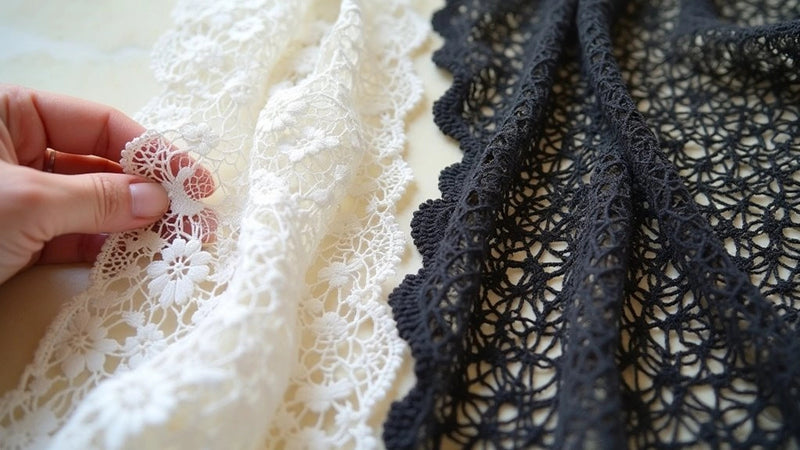
0 comments